What are the Side Effects of Keratin Treatment?
A surprising statistic reveals that a 2014 study of keratin brands marketed in South Africa found 6 out of 7 products contained formaldehyde levels up to 1.4 percent, exceeding the recommended safe level by five times. This concerning finding highlights the potential health risks associated with keratin Treatments, which have become increasingly popular for achieving smooth, straight, and shiny hair. Understanding the possible side effects of these Treatments is crucial for making an informed decision about their use.
Key Takeaways
- Keratin treatments can expose users to high levels of formaldehyde, a known carcinogen.
- Side effects range from mild irritation to more serious respiratory issues and potential long-term health concerns.
- The quality of the products used and the application techniques can significantly impact the risk of side effects.
- Certain individuals, such as those with sensitive skin or asthma, may be more susceptible to adverse reactions.
- Keratin treatments are not recommended for pregnant or breastfeeding individuals due to safety concerns.
By exploring the potential side effects of keratin treatments, this article aims to provide readers with a comprehensive understanding of the risks and considerations involved. Whether you are considering a keratin treatment or have already undergone one, being informed about the possible consequences can help you make The Best decision for your hair and overall health.
Understanding Keratin Treatment
Keratin treatment is a popular hair smoothing procedure that aims to transform unruly, frizzy locks into a sleek, manageable style. But what exactly is keratin, and how does this treatment work? Let’s dive in and explore the process and benefits of keratin treatment.
What Is Keratin Treatment?
Keratin treatment is a hair-smoothing process that adds keratin, a Natural protein found in hair, skin, and nails, to the hair shaft. This protein-infused treatment helps to seal and strengthen the hair cuticle, resulting in a smoother, shinier, and less frizzy appearance.
How Does It Work?
During a keratin treatment, a keratin-based solution is applied to the hair, and then the hair is sealed with high heat, often using a flat iron. This heat-sealing process helps to lock the keratin into the hair, creating a protective barrier that tames frizz and flyaways.
Benefits of Keratin Treatment
- Reduced frizz and increased shine: Keratin treatments help to smooth the hair cuticle, creating a sleeker, more polished look.
- Stronger, healthier hair: The keratin in the treatment helps to strengthen and fortify the hair, reducing breakage and improving overall hair health.
- Decreased styling time: Keratin-treated hair is easier to manage and style, saving time in your daily routine.
However, it’s important to note that many keratin treatments contain formaldehyde or related compounds, which can pose potential health risks. Consulting with a professional stylist and conducting thorough research is crucial when considering a keratin treatment.
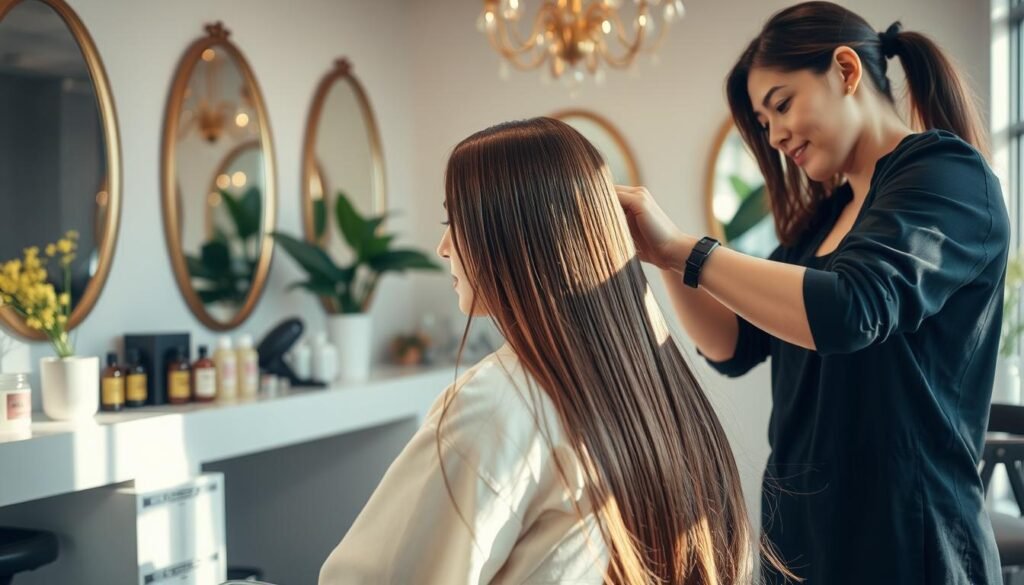
“Keratin treatments can be a game-changer for those with unruly, frizzy hair, but it’s essential to understand the process and potential side effects before undergoing the treatment.”
Common Side Effects of Keratin Treatment
While keratin treatments promise smoother, straighter, and more manageable hair, they are not without their risks. Common side effects of these popular hair-smoothing procedures include hair damage, skin irritation, and allergic reactions.
Hair Damage
The high heat and harsh chemicals used during the keratin treatment process can take a toll on the health of your hair. Excessive heat exposure from the flat iron can lead to dryness, frizz, and even hair breakage. In fact, studies have shown that 2.5% of salon-treated hair and 12.4% of home-treated hair experienced dryness after keratin treatments.
Skin Irritation
Keratin treatments often require applying the solution directly to the scalp and forehead, which can cause skin irritation for some individuals. Frizz was reported in 8.6% of cases, while scalp irritation was notable in 3.3% of those receiving the treatment.
Allergic Reactions
One of the most concerning side effects of keratin treatments is the potential for allergic reactions. The formaldehyde present in many keratin products can trigger allergic responses in 2.8% of treatment recipients, leading to symptoms like itching, burning sensations, rashes, and hives.
It’s important to be aware of these keratin treatment risks, keratin treatment dangers, and keratin treatment health concerns before deciding to undergo the procedure. Consulting a professional and conducting a patch test can help minimize the risk of adverse reactions.

Less Common Side Effects
While keratin treatments are generally well-tolerated, some individuals may experience less common but more serious side effects. Two notable issues that can arise are respiratory problems and eye irritation.
Respiratory Issues
Keratin treatments often contain formaldehyde, a toxic gas that can lead to coughing, wheezing, chest pain, and shortness of breath. In salon settings, where stylists are repeatedly exposed to these chemicals, the risk of developing asthma and other respiratory conditions increases. Prolonged keratin treatment formaldehyde exposure can have lasting effects on one’s respiratory health.
Eye Irritation
The fumes and chemicals used in keratin treatments can also cause eye irritation, ranging from mild discomfort to severe burning and potential corneal damage. This is particularly concerning for hairstylists who may experience keratin treatment respiratory problems due to their frequent proximity to these treatments.
While less common than other side effects, the respiratory and eye-related issues associated with keratin treatments should not be overlooked. Individuals considering this procedure, as well as professionals administering it, should be aware of these potential risks and take appropriate precautions to minimize exposure and protect their health.
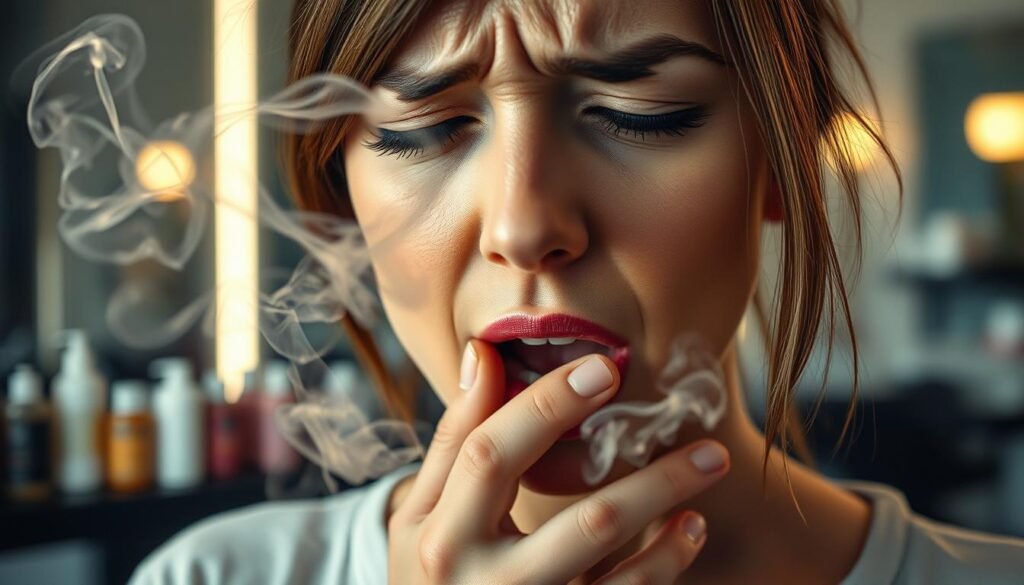
Factors Influencing Side Effects
When it comes to the potential side effects of keratin treatment, the quality of the product and the application technique play a crucial role. Some keratin treatment products contain higher levels of formaldehyde than advertised, increasing the risk of adverse reactions for those with sensitive skin or respiratory issues.
Proper application by a trained professional can minimize the risks associated with keratin treatments. Improper technique, however, may exacerbate potential side effects, such as hair damage, skin irritation, and allergic reactions. The frequency of treatments and an individual’s sensitivity to the chemicals used can also influence the likelihood and severity of side effects.
Product Quality
Keratin treatment prices can vary depending on factors such as hair type, salon reputation, and location. Formaldehyde-free keratin treatments are typically more expensive than traditional treatments but are considered safer. Choosing a reputable salon that uses high-quality, formaldehyde-compliant products is crucial to minimize the keratin treatment safety risks.
Application Technique
The skill and experience of the stylist performing the keratin treatment are essential. Trained and certified professionals who specialize in keratin treatments are more likely to apply the product correctly and minimize potential side effects. Improper application can lead to keratin treatment product quality issues, such as uneven distribution or excessive heat exposure, which can exacerbate hair damage and other adverse reactions.
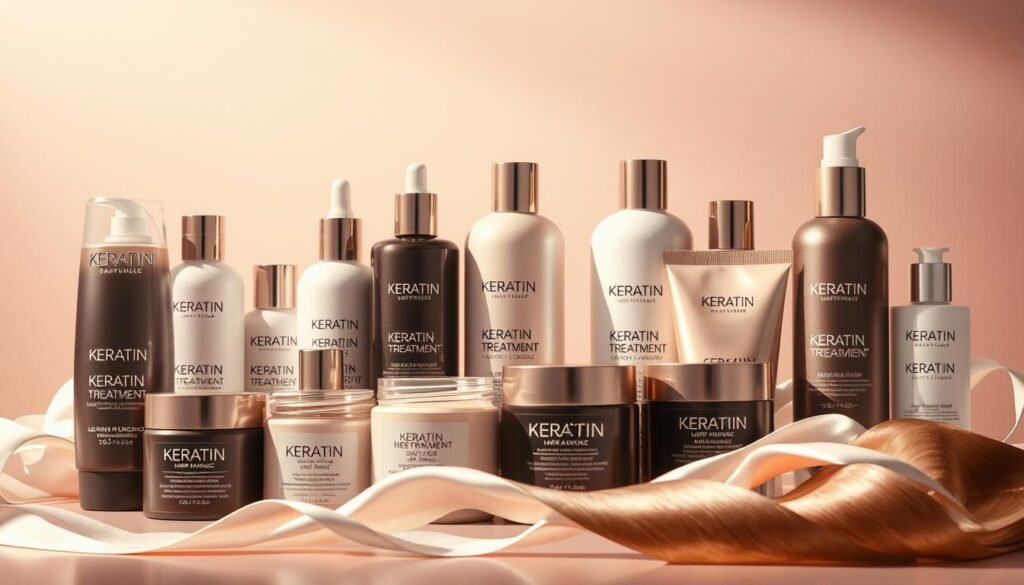
“Choosing a reputable salon with experienced stylists is crucial to minimize the risks associated with keratin treatments.”
Duration of Side Effects
When it comes to the side effects of keratin treatments, it’s crucial to understand that they can manifest both in the immediate aftermath and over the long term. Immediate reactions often include skin and eye irritation, headaches, and respiratory discomfort, which typically subside within hours or days after the treatment.
Immediate Reactions
The application of keratin treatments involves the use of various chemicals, including formaldehyde, which can trigger immediate adverse reactions in some individuals. These may include:
- Skin irritation and redness
- Eye irritation and watering
- Headaches or dizziness
- Respiratory issues, such as coughing or difficulty breathing
These immediate side effects are typically short-lived and should dissipate as the body adjusts to the chemicals used in the treatment.
Long-Term Effects
The long-term effects of keratin treatments are less understood, but they can potentially be more concerning. Repeated exposure to the formaldehyde present in many keratin products has been linked to an increased risk of certain health issues, including:
- Increased cancer risk: Formaldehyde has been classified as a known human carcinogen, raising concerns about the long-term effects of repeated exposure through keratin treatments.
- Fertility issues: Some studies have suggested that formaldehyde exposure may contribute to fertility problems, particularly for salon workers who are regularly exposed to the chemicals.
- Chronic respiratory problems: Prolonged exposure to the fumes and airborne particles generated during keratin treatments can lead to chronic respiratory issues, such as asthma or lung function changes.
It’s important to note that the long-term risks of keratin treatments are still being investigated, and the severity of these effects can vary depending on factors such as the frequency of treatments, the specific products used, and individual sensitivity.

When considering a keratin treatment, it’s essential to weigh the potential benefits against the possible short-term and long-term side effects. Consulting with a qualified hair care professional and being mindful of your body’s reactions can help you make an informed decision and minimize the risks associated with these treatments.
Who Should Avoid Keratin Treatments?
While keratin treatments can offer transformative results for many individuals, certain groups should consider avoiding these treatments due to heightened health risks. Pregnant individuals and those with sensitive skin are advised to steer clear of keratin treatments.
Pregnant Individuals
Pregnant women should be particularly cautious when it comes to keratin treatments. The formaldehyde present in many traditional keratin formulas can potentially pose fertility-related risks and increase the likelihood of miscarriage. Exposure to this chemical during pregnancy is not recommended, as the potential long-term effects on the developing fetus are not fully understood.
Those with Sensitive Skin
Individuals with sensitive skin, allergies, or pre-existing respiratory conditions such as asthma may also be at a higher risk of experiencing adverse reactions to keratin treatments. The potent chemicals used in these treatments can trigger skin irritation, burning sensations, and even breathing difficulties in some cases. Those with damaged or overly processed hair may also find that keratin treatments cause further hair damage.
Before considering a keratin treatment, it is crucial to consult with a healthcare professional or a trusted stylist to assess the potential risks and determine The Best course of action for your unique hair and health needs.
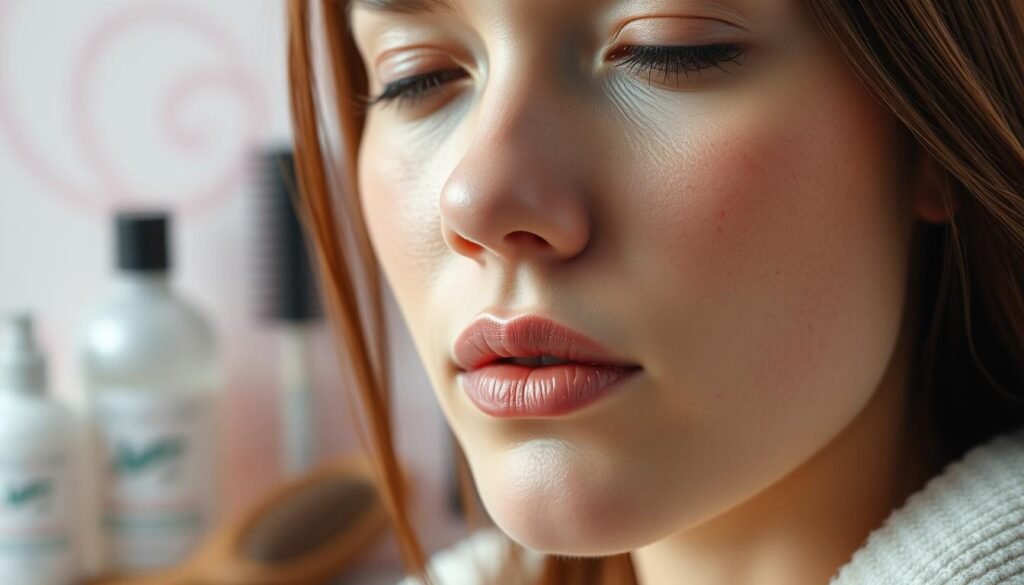
Tips for Minimizing Side Effects
Keratin treatments can be a game-changer for achieving smooth, frizz-free hair. However, it’s essential to take precautions to minimize any potential side effects. The key is to be proactive and prioritize your safety when undergoing this transformative hair treatment.
Patch Testing: The First Step
Before committing to a full keratin treatment, it’s crucial to conduct a patch test. This simple procedure involves applying a small amount of the keratin solution to a discreet area of your skin, usually behind the ear or on the inner arm. Wait 24-48 hours to monitor for any signs of skin irritation or allergic reactions. This step can help you avoid unpleasant surprises during the actual treatment.
Choosing the Right Salon
When it comes to keratin treatment salon selection, do your research. Seek out reputable salons with experienced stylists who use high-quality, formaldehyde-free products. Ensure proper ventilation in the salon, and ask about the specific ingredients in the treatment. Carefully compare different brands and their safety records to make an informed decision.
Prioritizing your safety and well-being is the best way to enjoy the transformative benefits of keratin treatments while minimizing the risks of keratin treatment safety precautions. By taking these proactive steps, you can achieve the smooth, manageable hair you desire without compromising your health.

Alternatives to Keratin Treatment
As concerns grow over the potential health risks associated with traditional keratin treatments, many individuals are seeking safer alternatives to achieve smooth, frizz-free hair. Fortunately, there are several Natural Hair treatments and other smoothing options available that can provide similar benefits without exposing users to harmful chemicals like formaldehyde.
Natural Hair Treatments
Natural Hair treatments, such as hot oil treatments with coconut, argan, or olive oil, can help reduce frizz and add shine to the hair without the use of harsh chemicals. These treatments work by deeply conditioning the hair and sealing the cuticle, resulting in a smooth, manageable appearance.
Other Hair Smoothing Options
Alternative hair smoothing treatments, like Japanese thermal reconditioning and tourmaline hair-smoothing treatments, offer formaldehyde-free solutions for achieving a sleek, straight look. These options utilize advanced technologies and Natural ingredients to provide long-lasting results without the potential health risks associated with keratin treatments.
| Treatment | Description | Formaldehyde-Free | Longevity |
|---|---|---|---|
| Japanese Thermal Reconditioning | A chemical-free, heat-based treatment that straightens and smooths hair | Yes | Up to 6 months |
| Tourmaline Hair Smoothing | A treatment that uses tourmaline-infused tools to reduce frizz and add shine | Yes | Up to 3 months |
| Organic Nano Gel | A natural, nutrient-rich treatment that smooths and strengthens hair | Yes | Up to 3 months |
By exploring these keratin treatment alternatives and natural hair smoothing treatments, individuals can achieve the desired salon-smooth results while prioritizing their health and well-being.

Aftercare for Keratin-Treated Hair
Proper keratin treatment aftercare is crucial for maintaining the results of your treatment and minimizing potential damage. To ensure your keratin treatment lasts up to 6 months, follow these essential tips:
Recommended Products
Use sulfate-free, sodium chloride-free shampoos and conditioners to prolong the treatment’s effects. Avoid washing your hair for at least 72 hours after the treatment to allow the keratin to set.
Maintenance Tips
- Limit heat styling and use heat protectant products when necessary.
- Incorporate regular deep conditioning treatments to keep your hair healthy and maintain the smoothing effect.
- Be cautious with hair ties and avoid sleeping on wet hair to prevent breakage.
- Keep your hair down for the first three days to avoid creases or dents.
- Use a silk pillowcase to reduce friction and minimize damage.
- Avoid activities like swimming, sauna, or intense exercise that can cause premature bleeding of the treatment.
- Wait at least 3 weeks before using salon chemicals to allow the keratin treatment to settle.
By following these keratin treatment maintenance tips, you can preserve the smooth, healthy appearance of your hair and extend the life of your treatment.

Consult a Professional
When it comes to keratin treatment, consulting a professional is crucial. An experienced stylist or trichologist can assess your hair type, condition, and any potential risks, ensuring you receive the most suitable treatment or alternatives based on your hair goals and health concerns.
Importance of Expert Advice
Keratin treatments can have significant benefits, but they also come with potential side effects. A professional can Guide you through the process, explaining the treatments, the potential risks, and how to mitigate them. They can also help you understand the long-term implications and maintenance required to keep your hair healthy and vibrant.
Finding the right Stylist
- Look for stylists with certifications and extensive experience in keratin treatments.
- Ensure the stylist is knowledgeable about the different types of keratin treatments and can recommend the best option for your hair.
- Ask about the salon’s safety practices, such as proper ventilation and use of protective gear during the application process.
- Inquire about the specific products they use and their potential side effects.
A good professional should be transparent about the products used and their potential risks. They should also be able to provide personalized guidance on maintaining your keratin-treated hair.
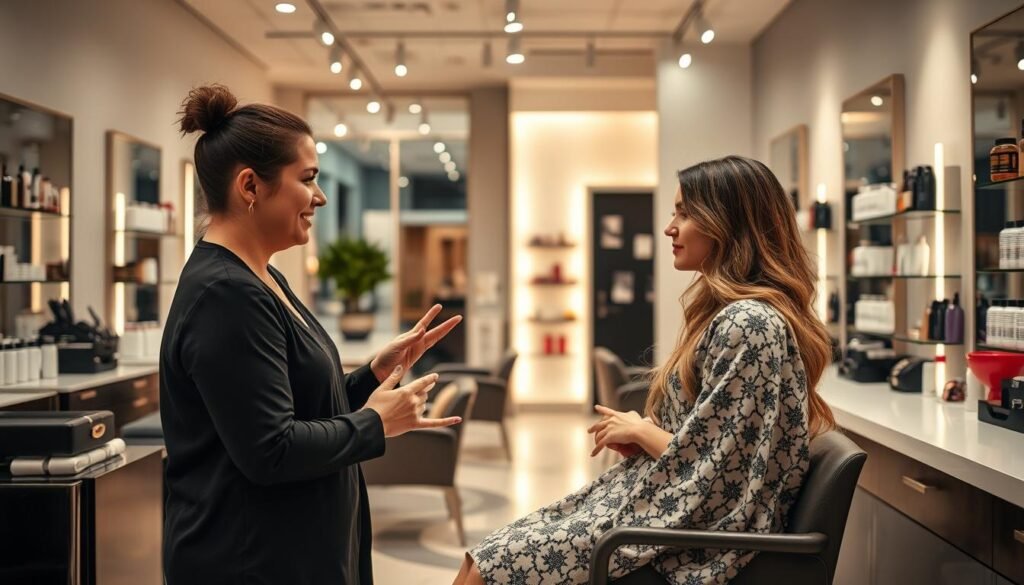
Remember, keratin treatment expert advice can make all the difference in ensuring a safe and successful experience. Take the time to find the right stylist who can help you achieve the smooth, manageable hair you desire while minimizing any potential side effects.
Conclusion
Deciding whether to undergo a keratin treatment requires a careful evaluation of the potential risks and benefits. While these treatments can provide smoother, more manageable hair, they also come with potential health concerns, particularly due to the presence of formaldehyde in some products. Factors such as your hair type, health status, and long-term hair goals should be carefully considered before making a decision.
Weighing Risks and Benefits
Keratin treatments offer aesthetic benefits, such as reduced frizz and increased shine, but they also carry risks, including hair damage, skin irritation, and allergic reactions. The long-term effects of formaldehyde exposure are also a concern, as this chemical has been linked to respiratory issues and other health problems. Thoroughly researching the quality of the products used and the application techniques employed at the salon can help mitigate these risks.
Making an Informed Choice
Before deciding on a keratin treatment, it’s essential to consult with a professional stylist or dermatologist to understand the potential risks and benefits based on your individual needs and hair condition. Exploring safer alternatives, such as natural hair treatments or other smoothing options, may also be worth considering. Ultimately, the decision should be based on a thorough understanding of the trade-offs and a commitment to maintaining your hair’s health and condition.
FAQ
What are the side effects of keratin treatment?
Common side effects of keratin treatments include hair damage from excessive heat and chemicals, skin irritation on the scalp and forehead, and allergic reactions such as itching, burning sensations, rashes, or hives. Exposure to formaldehyde, a key ingredient in many keratin treatments, can also cause eye, nose, and throat irritation, as well as headaches and nausea.
What are the risks of keratin treatments?
Keratin treatments can pose health risks, particularly due to the presence of formaldehyde, a known carcinogen. Less common but more serious side effects include respiratory issues like coughing, wheezing, chest pain, and shortness of breath, as well as eye irritation ranging from mild discomfort to severe burning and potential corneal damage.
Can keratin treatments cause long-term health problems?
The long-term effects of keratin treatments are less understood, but may include increased cancer risk due to repeated formaldehyde exposure, potential fertility issues, and chronic respiratory problems, especially for salon workers regularly exposed to the chemicals.
Who should avoid keratin treatments?
Pregnant individuals, people with sensitive skin or allergies, and those with pre-existing respiratory conditions like asthma should avoid keratin treatments due to the increased health risks. Individuals with damaged or overly processed hair may also experience further hair damage from the treatment.
How can I minimize the side effects of keratin treatments?
To minimize side effects, consider patch testing before a full treatment, choose a reputable salon with experienced stylists who use high-quality, formaldehyde-free products, ensure proper ventilation in the salon, and research different brands and their safety records. Explore safer alternatives to traditional keratin treatments, such as natural hair treatments or formaldehyde-free smoothing options.
What is the best way to care for keratin-treated hair?
Proper aftercare is crucial for maintaining the results of a keratin treatment and minimizing potential damage. Use sulfate-free, sodium chloride-free shampoos and conditioners, avoid washing hair for at least 72 hours after treatment, limit heat styling, and regularly deep condition to keep hair healthy and maintain the smoothing effect.
When should I consult a professional about keratin treatments?
Consulting a professional, such as a stylist or trichologist, is crucial before deciding on a keratin treatment. They can assess your hair type, condition, and any potential risks, and recommend the most suitable treatment or alternatives based on your hair goals and health concerns.





